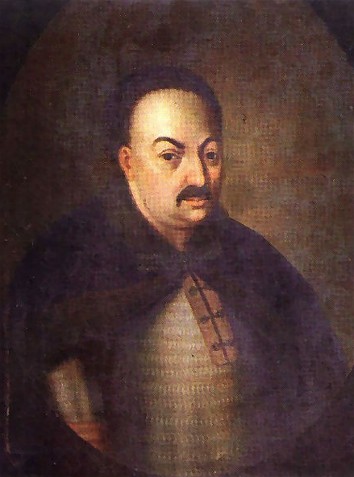Samoilovych, Ivan
Samoilovych, Ivan [Samojlovyč] (Popovych), b ? in Khodorkiv, Skvyra region, d 1690 in Tobolsk, Siberia. (Portrait: Ivan Samoilovych.) Cossack leader. He studied at the Kyivan Mohyla College until 1648. During the tenure of Hetman Demian Mnohohrishny he served as colonel of Chernihiv regiment (1668–9) and as general judge (1669–72). After Mnohohrishny was deposed, Samoilovych was elected hetman at a Cossack general council held near Konotop in June 1672 (see Konotop Articles). He sought to unite Left-Bank Ukraine and Right-Bank Ukraine under his rule and fought against the Right-Bank hetman, Petro Doroshenko. On 17 March 1674 a council of 10 senior Cossack starshyna officers of Right-Bank Ukraine recognized him as their hetman, but he could not rule de facto until Doroshenko abdicated, on 19 September 1676. Samoilovych also sought to join the regiments of Slobidska Ukraine to the Hetman state, but that aim was decisively opposed by Moscow.
Samoilovych opposed a Muscovite-Polish alliance, which would have been detrimental to Ukraine, but he supported peaceful relations between Moscow and the Crimean Khanate and Turkey. The Chyhyryn campaigns, 1677–8, of the Turks, however, which devastated Right-Bank Ukraine and resulted in a mass forced migration to Left-Bank Ukraine (1680), brought about Samoilovych's political demise. The Eternal Peace of 1686 between Moscow and Poland (opposed vigorously by Samoilovych) officially confirmed the partition of the Hetman state and drew it into another war against Turkey and the Crimea (campaigns in 1687 and 1689).
Samoilovych favored an authoritarian system of rule. As the self-proclaimed absolute ruler of the Little Russian State he was probably the first to formulate theoretically the hetmancy as a monarchic institution based on divine right. He wanted to secure hereditary rule of the Hetman state for his sons, to whom he gave the best regimental governments and huge estates. Under his regime there was a significant economic resurgence in Left-Bank Ukraine. Trade with Western Europe resumed, and economic ties with Muscovy, the Balkans, the Don region, and Caucasia were strengthened. Internal trade also improved, between the Hetman state in the north and the Zaporizhia in the south and between Slobidska Ukraine and Right-Bank Ukraine. Various trades and industries began to develop, and cultural life, which had suffered during the years of the Ruin, was invigorated. The construction of large new churches (eg, the Mhar Transfiguration Monastery) was financed by Samoilovych and his senior starshyna. Under his rule, however, the Moscow patriarchate began to subvert the Ukrainian church, and subjugated it finally in 1686.
Samoilovych's despotism aroused considerable opposition among the senior Cossack starshyna, and they began plotting against him as his health failed. Abetted by the Muscovite government and capitalizing on the failure of the 1687 Crimean campaign, they charged him with arbitrariness and corruption and even accused him of establishing secret treasonous contacts with the Crimean khan. Samoilovych was deposed at the behest of Moscow at the Cossack general council on the Kolomak River (see Kolomak Articles); his assets were seized, and he was exiled to Tobolsk.
Oleksander Ohloblyn
[This article originally appeared in the Encyclopedia of Ukraine, vol. 4 (1993).]
